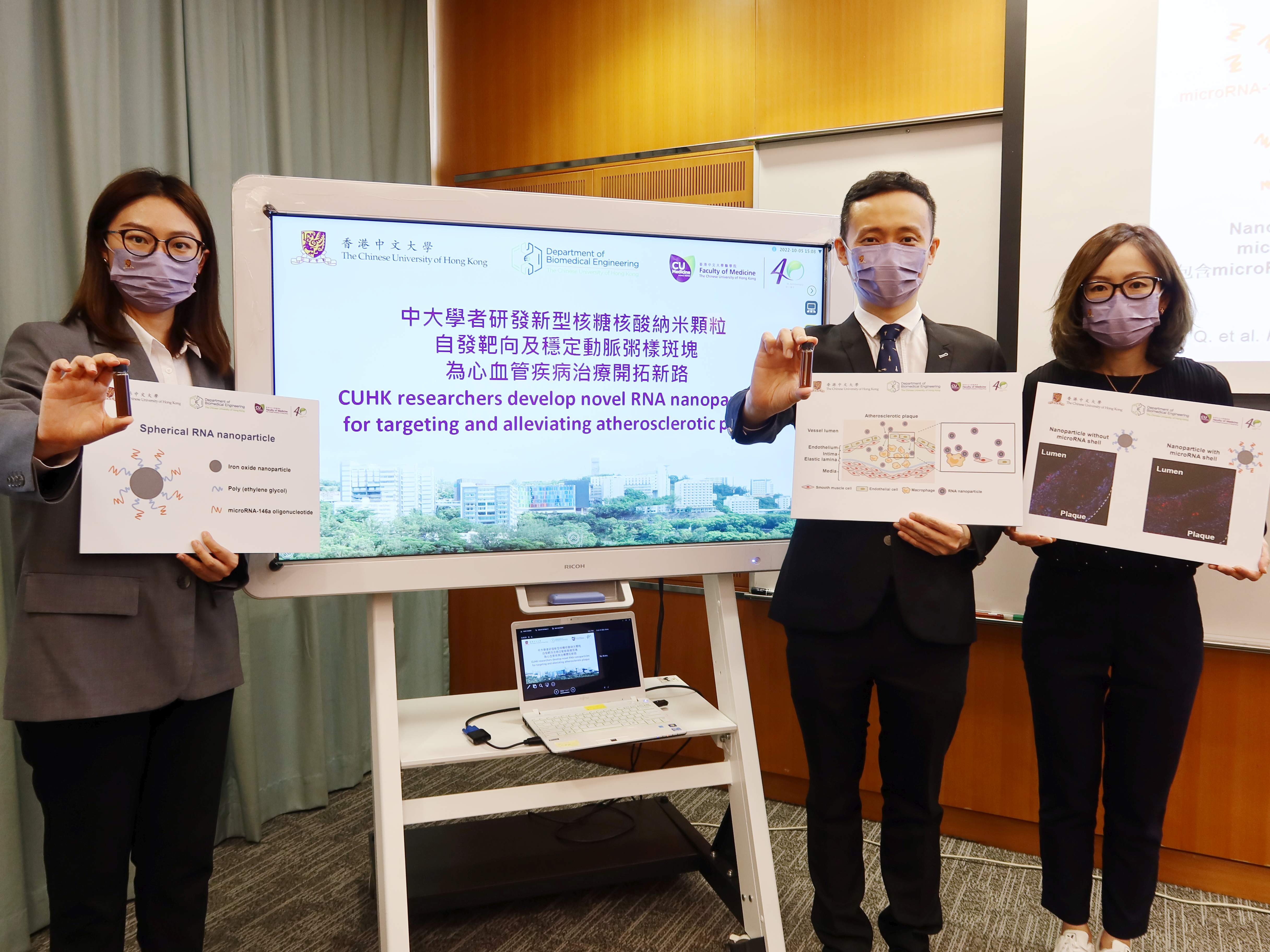田小雨教授參與研發新型核糖核酸納米顆粒協作項目
Gene regulation is an emerging therapeutic approach to atherosclerosis, but delivery of therapeutic gene cargoes to atherosclerotic plaques is still inefficient. A team led by Prof. Jonathan C.H. Choi, Department of Biomedical Engineering, Faculty of Engineering of CUHK, collaborated with Prof. Tian Xiaoyu, School of Biomedical Sciences (SBS), Faculty of Medicine of CUHK, to develop a novel RNA nanoparticle to offer a potentially safe, effective treatment for atherosclerosis. The related findings have been published in the international journal The Proceedings of the National Academy of Sciences (PNAS), which can be viewed HERE.
Prof. Tian, the co-corresponding author said, “The findings suggest that this RNA nanoparticle is a safe, effective agent to treat atherosclerosis, and it is now possible to design nucleic acid nanomedicines that are dual plaque targeting and therapeutic agents.” Prof. Choi added, “This study highlights the promise of nucleic acid nanotechnology to treat cardiovascular diseases. We hope to continue our collaboration with the CUHK Faculty of Medicine by validating the safety and efficacy of this RNA nanostructure in large animals. Ultimately, we hope to offer a safe, effective nanomedicine for patients with cardiovascular disease.”
The related coverage by the Communications and Public Relations Office, CUHK can be viewed HERE.

(From left) Dr. Shirley Q. Bai and Prof. Jonathan Choi of Department of Biomedical Engineering, and Prof. Tian Xiaoyu, SBS

The outer microRNA shell promotes the delivery of nanoparticles to the plaque upon intravenous injection into mice with atherosclerosis
基因調控是一種新興治療動脈粥樣硬化的方法,但基因藥物遞送往動脈粥樣斑塊的效率仍有不足。有見及此,中大工程學院生物醫學工程學系蔡宗衡教授及其團隊,與醫學院生物醫學學院田小雨教授合作,研發出一款新型核糖核酸(RNA)納米顆粒,為治療動脈粥樣硬化提供安全有效的潛在方案。有關研究結果已於國際學術期刊《美國國家科學院院刊》(The Proceedings of the National Academy of Sciences)發表,論文全文可按此處參閱。
在本學院4名教研人員的指導下,6名2年級醫科生參加為期八星期的暑期研究實習計劃,參與研究項目以獲得實踐研究經驗及技巧(見以下表格)。此計劃旨在培養內外全科醫學士課程—環球醫學領袖培訓專修組別的學生發展研究能力,協助發展成為未來醫生及科學家。
中大傳訊及公共關係處的有關報導請按此處瀏覽。

(左起)生物醫學工程學系柏芊芊博士及蔡宗衡教授、以及生物醫學學院田小雨教授

RNA納米顆粒外層以microRNA連接組成,以靜脈注射到患有動脈粥樣硬化的小鼠體內後,令納米顆粒更有效地遞送至斑塊
基因调控是一种新兴治疗动脉粥样硬化的方法,但基因药物递送往动脉粥样斑块的效率仍有不足。有见及此,中大工程学院生物医学工程学系蔡宗衡教授及其团队,与医学院生物医学学院田小雨教授合作,研发出一款新型核糖核酸(RNA)纳米颗粒,为治疗动脉粥样硬化提供安全有效的潜在方案。有关研究结果已于国际学术期刊《美国国家科学院院刊》(The Proceedings of the National Academy of Sciences)发表,论文全文可按此处参阅。
在本学院4名教研人员的指导下,6名2年级医科生参加为期八星期的暑期研究实习计划,参与研究项目以获得实践研究经验及技巧(见以下表格)。此计划旨在培养内外全科医学士课程—环球医学领袖培训专修组别的学生发展研究能力,协助发展成为未来医生及科学家。
中大传讯及公共关系处的有关报导请按此处浏览。

(左起)生物医学工程学系柏芊芊博士及蔡宗衡教授、以及生物医学学院田小雨教授

RNA纳米颗粒外层以microRNA连接组成,以静脉注射到患有动脉粥样硬化的小鼠体内后,令纳米颗粒更有效地递送至斑块



